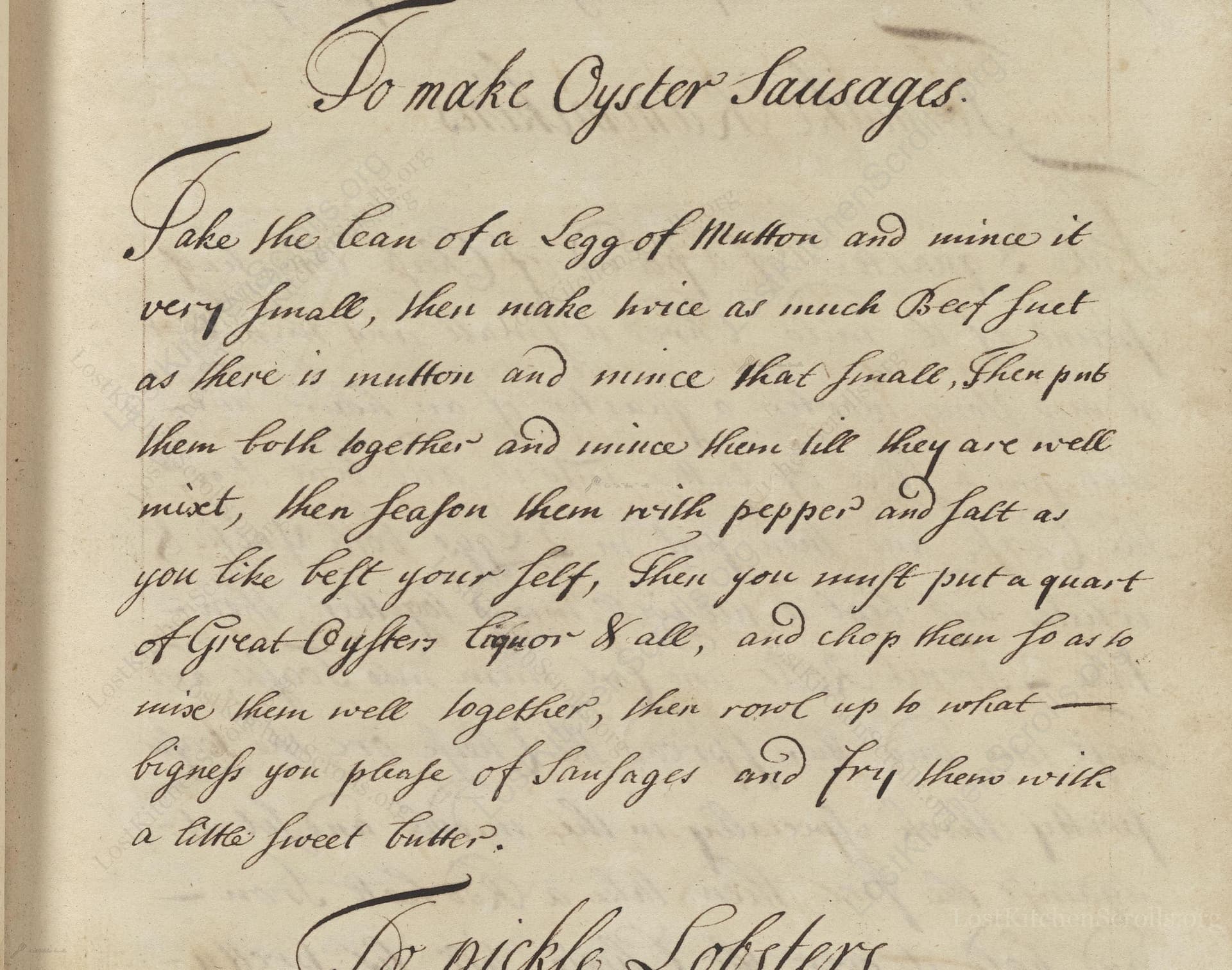To Make Oyster Sausages
From the treasured pages of Various Cookeries
Unknown Author

To Make Oyster Sausages
"Take the lean of a Legg of Mutton and mince it very small, then take twice as much Beef suet as there is mutton and mince that small, Then put them both together and mince them till they are well mixt, then season them with pepper and salt as you like best your self, Then you must put a quart of Great Oysters liquor & all, and chop them so as to mixe them well together, then rowl up to what-bigness you please of Sausages and fry them with a little sweet butterr."
Note on the Original Text
Written before the rise of formalized standardized recipes, this text is direct yet flexible, leaving seasoning and sizing to the cook’s discretion. Unusual spellings ('rowl', 'legg', 'mixe') reflect 17th-century orthography, when English spelling had not yet been standardized. Instructions glide from one step to another, expecting the reader to possess basic cooking knowledge. Quantities are imprecise, often described by proportion, allowing for personal adjustment. This reflects both the variable nature of household ingredients and the wisdom of experienced cooks who rarely needed explicit measurements.

Title
Various Cookeries (1690)
You can also click the book image above to peruse the original tome
Writer
Unknown
Era
1690
Publisher
Unknown
Background
A delightful glimpse into late 17th-century kitchens, this book brims with recipes, methods, and culinary wisdom passed down through generations, capturing the essence of historical gastronomy.
Kindly made available by
Folger Shakespeare Library
This recipe hails from the late 1600s, a time when English kitchens enthusiastically combined robust meats with the brininess of oysters. Oysters were common and affordable for all classes, giving rise to their starring role in both land and sea dishes. Sausages like these reflect an opulent mixing of ingredients: the richness of mutton and suet, fused with the freshness of oysters, speaks to the era's culinary creativity and sense of abundance. Recipes were transmitted orally or scribbled in household recipe books, often owned by women managing large households. This Oyster Sausages recipe is a stellar example of Anglo-Dutch influences and the embracing of both local produce and imported flavors.

In a 17th-century kitchen, the cook would use a heavy chopping knife and broad wooden board for mincing the meat and suet—a laborious, rhythmic task. The shellfish would be shucked with a stout oyster knife. All ingredients would be mixed in a large wooden or earthenware bowl. Sausages would typically be shaped by hand, sometimes encased, but often simply rolled. For frying, a heavy metal pan (iron or copper) would be set over an open fire or placed on a range, using sweet butter for cooking.
Prep Time
30 mins
Cook Time
25 mins
Servings
8
We've done our best to adapt this historical recipe for modern kitchens, but some details may still need refinement. We warmly welcome feedback from fellow cooks and culinary historians — your insights support the entire community!
Ingredients
- 1 pound 2 ounces lean mutton leg (or lamb leg as substitute)
- 2 pounds 3 ounces beef suet (or best-quality kidney fat; for substitutes, use beef fat mixed with a little butter)
- 1 quart large fresh oysters, with their liquor (or 1 pound 12 ounces drained oysters + 7 fluid ounces oyster liquor)
- Salt, to taste
- Black pepper, freshly ground, to taste
- 3/4–1 1/2 ounces (1 1/2–3 tablespoons) unsalted butter, for frying
Instructions
- Begin by finely mincing about 1 pound 2 ounces of lean mutton leg.
- Take 2 pounds 3 ounces (1 kilogram) of beef suet and chop it finely as well.
- Mix the mutton and suet thoroughly, continuing to mince until well-blended.
- Season generously with freshly ground black pepper and fine sea salt to taste.
- Add 1 quart of large fresh oysters (with their liquor), roughly chopping them to integrate evenly.
- Combine all ingredients into a uniform mixture.
- Shape the mixture into sausage forms of your preferred size.
- Heat a little unsalted butter in a frying pan over medium heat, and fry the sausages in batches until golden brown and cooked through.
- Serve hot.
Estimated Calories
540 per serving
Cooking Estimates
Preparing this dish takes about 30 minutes, including chopping meat and mixing ingredients. Cooking the sausages in batches takes around 25 minutes. Each serving has about 540 calories, and this recipe makes 8 servings.
As noted above, we have made our best effort to translate and adapt this historical recipe for modern kitchens, taking into account ingredients nowadays, cooking techniques, measurements, and so on. However, historical recipes often contain assumptions that require interpretation.
We'd love for anyone to help improve these adaptations. Community contributions are highly welcome. If you have suggestions, corrections, or cooking tips based on your experience with this recipe, please share them below.
Join the Discussion
Rate This Recipe

Den Bockfisch In Einer Fleisch Suppen Zu Kochen
This recipe hails from a German manuscript cookbook compiled in 1696, a time whe...

Die Grieß Nudlen Zumachen
This recipe comes from a rather mysterious manuscript cookbook, penned anonymous...

Ein Boudain
This recipe comes from an anonymous German-language manuscript cookbook from 169...

Ein Gesaltzen Citroni
This recipe, dating from 1696, comes from an extensive anonymous German cookbook...
Browse our complete collection of time-honored recipes



